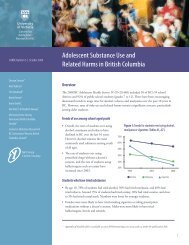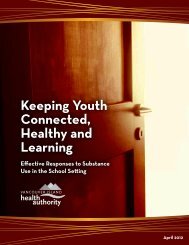A Review Of Research Into The Impacts Of Alcohol ... - CARBC
A Review Of Research Into The Impacts Of Alcohol ... - CARBC
A Review Of Research Into The Impacts Of Alcohol ... - CARBC
Create successful ePaper yourself
Turn your PDF publications into a flip-book with our unique Google optimized e-Paper software.
2. Material identified from scholarly databases<br />
<strong>The</strong> scholarly databases PsychInfo, Medline, and the Social<br />
Science Citation Index were searched using variations of the<br />
terms “warning label/alcohol warning label/alcohol warning/<br />
beverage warning” for the years 1995 to 2004. In addition,<br />
variations of the terms “health warning/ health warning labels/<br />
tobacco warning labels/tobacco warning” were used to search<br />
these databases for the years 2000 to 2004. <strong>The</strong>se databases<br />
enable the titles and abstracts of papers published in peerreviewed<br />
medical, psychosocial and scientific journals to be<br />
searched using particular search terms. <strong>The</strong>se searches yielded<br />
three review papers that specifically focused on the effectiveness<br />
of alcohol warning labels. In addition, three other recent, more<br />
general reviews of the impacts of different alcohol policies and<br />
strategies were identified by the author from recent authoritative<br />
and comprehensive studies. Ten reports focusing on the<br />
impacts of alcohol warning labels in different populations were<br />
identified, several of which were different analyses of the same<br />
study, and nearly all concerned the impacts of US warning<br />
labels. A further 18 reports were available for analysis from the<br />
author’s own collection regarding the US experience with alcohol<br />
warning labels. <strong>The</strong> majority of these papers were from the<br />
<strong>Alcohol</strong> <strong>Research</strong> Group based in Berkeley, California, which<br />
was commissioned by the National Institute on <strong>Alcohol</strong> Abuse<br />
and <strong>Alcohol</strong>ism to analyse the impacts of the US warning labels<br />
introduced in 1989. Not all these papers are discussed here, only<br />
those that report the latest or last outputs from a series of studies<br />
and those that contribute something unique regarding impacts of<br />
labels that have actually been used.<br />
In relation to tobacco warning labels, three general reviews of the<br />
effectiveness of alternative tobacco control strategies and nine<br />
individual studies of the impact of tobacco warning labels on<br />
smokers’ knowledge, beliefs, intentions and smoking behaviour<br />
were identified.<br />
3. Conclusions from alcohol policy reviews<br />
<strong>Review</strong>s of the evidence supporting the full range of available<br />
alcohol policy strategies spanning legislative, regulatory and<br />
educational have mostly concluded that there is little or no<br />
measurable change in drinking behaviour and related harms as a<br />
result of the introduction of alcohol warning labels. Two reviews<br />
prepared by alcohol-industry-funded bodies (one peer-reviewed)<br />
have concluded both that the evidence is negative and that labels<br />
should not be used. Among four other reviews from groups<br />
of independent academics, impacts on intervening variables<br />
such as awareness of the labels and discussion of their messages<br />
were identified, but most considered there was no evidence of<br />
change in risk behaviours. One of these reviews (Greenfield,<br />
1997) highlighted evidence suggesting that people who saw<br />
the labels were less likely to say they had driven “when they<br />
probably should not have”. All of these last four reviews ended<br />
by recommending some enhancement of the labels to make<br />
them more effective. A review of the evidence for standard drink<br />
labelling in Australia concluded this was “promising” but by no<br />
means conclusive.<br />
<br />
Considering these reviews in turn, Agostinelli and Grube (2002)<br />
reviewed evidence to support a variety of “counter alcohol<br />
advertising strategies”, including public education campaigns<br />
and warning labels. <strong>The</strong>y conclude that warning labels have<br />
the potential to influence behaviour but this depends on their<br />
design, the content of the messages, and how well they are<br />
targeted at their intended audience.<br />
Babor et al (2003) conducted a systematic review of the evidence<br />
for a variety of alcohol control and educational policies from<br />
peer-reviewed research published up to the year 2000. This<br />
group comprised 15 experienced alcohol researchers from nine<br />
countries, and the project was sponsored by the World Health<br />
Organization. <strong>The</strong> group considered that only one well-designed<br />
study had been conducted (the US surveys led by Greenfield and<br />
colleagues), and that this study found some evidence of change<br />
in some intervening variables such as prompting target groups to<br />
discuss the health effects of drinking, but could not demonstrate<br />
change in drinking behaviour. <strong>The</strong> group commented that, given<br />
the relatively small size, the obscurity and lack of variation in the<br />
labels, it is remarkable that any effects at all were demonstrated.<br />
<strong>The</strong>y also noted that the cost to implement this strategy was low.<br />
Loxley et al (2003) report a substantial review of the evidence<br />
base for prevention of risky substance use and harmful outcomes<br />
commissioned by the Australian Government. <strong>The</strong> concept of<br />
standard drink labelling on alcohol containers, in place there<br />
for the last ten years, was rated as “promising”, especially in<br />
combination with and in support of other evidence-based<br />
strategies such as brief interventions by general practitioners,<br />
drink driving campaigns, and the promotion of national<br />
drinking guidelines. <strong>Alcohol</strong> warning labels were not specifically<br />
evaluated.<br />
Greenfield (1997), who led the major study of evaluating the<br />
US warning labels through a series of large national surveys,<br />
provided a more positive assessment, citing evidence of small<br />
but significant changes in terms of reductions in drink driving<br />
behaviour associated with recall of the anti-drink-driving<br />
message from this research program. He also noted evidence<br />
of warning labels prompting discussions about the dangers<br />
of drinking, steadily increased awareness of the labels, and<br />
evidence of increased public support for alcohol labelling by the<br />
US public following its introduction. He also emphasised the<br />
ability of warning labels to target high-risk drinkers who had<br />
significantly higher recall of label messages.<br />
Andrews (1995) reviewed the early evidence on the US warning<br />
label experience and highlighted the fact that, despite evidence<br />
of increased awareness of risks among heavy drinkers, they still<br />
appeared resistant to changing their behaviour. Based on the<br />
experience with the tobacco warning labels, he recommended<br />
a broader range of educational measures, including enhanced<br />
warning messages.<br />
Stockley (2001), a researcher employed at the Australian Wine<br />
<strong>Research</strong> Institute, reviewed the evidence for alcohol warning<br />
labels and concluded that there was no evidence that they<br />
Centre for Addictions <strong>Research</strong> of BC





